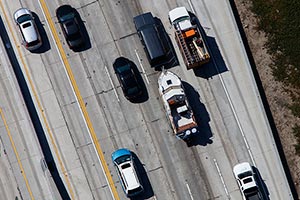Traffic Deaths Jump by Most Since 1966, Safety Group Says

Traffic fatalities increased in 2015 by an amount not seen in 50 years, alarming road safety advocates. The trend in Texas, which has the deadliest highways in the country, remained largely unchanged.
The National Safety Council on Feb. 17 announced that preliminary analysis showed 38,300 roadway deaths in the United States last year. That was an increase of 8% from 2014, the highest year-to-year jump since 1966.
"These numbers are serving notice: Americans take their safety on the roadways for granted," said Deborah Hersman, president and CEO of the safety council and former chairwoman of the National Transportation Safety Board.
Texas led the nation with 3,490 deaths on roads and highways. Despite California having roughly 12 million more residents, it had 240 fewer traffic deaths.
Texas’ fatality trend was stable, however. The number of deaths increased 1% from 2014 to 2015 and 4% from 2013 to 2015.
“There’s a lot of improvement (needed) for Texas,” Hersman said, noting the state lacks any statewide bans on distracted driving and Houston is frequently among the top metro areas for alcohol-related crashes. “But, it didn’t have the increases we saw in other states.”
The report underscores a recent push in Houston to improve traffic safety. A report by Houston Tomorrow, which advocates for less development of road capacity, found that Houston had more roadway deaths than New York, which is roughly four times Houston’s size.
Houston’s economic growth has meant more vehicles on the road, the local analysis concluded, and a corresponding jump in traffic fatalities.
The same bleak conclusion was painted by the National Safety Council report. As vehicle miles traveled have increased in the U.S. and gasoline prices dropped, Hersman said, roadway deaths jumped.
The National Safety Council data is different from fatality reports analyzed by the National Highway Traffic Safety Administration because NHTSA considers fatalities within 30 days of the roadway crash, while the safety council logs all deaths within one year of the incident.
Though drivers log more total miles on urban roads and freeways, nearly half the increase in traffic deaths occurred on rural roads.
“Those are the deadliest roads that people drive on," Hersman said, noting how unlighted, curvy roads are more difficult to drive and become particularly treacherous when drivers are drowsy or impaired.
Despite the glum report, Hersman said there are signs of improvement. Seat belt use remains high, though fatality data indicates fewer people in fatal crashes were wearing a seat belt.
The greatest hope, however, comes from technology that corrects or eliminates a driver’s errors.
“While drivers still may be pretty consistent with their bad habits… the real key is what’s going on with the car,” Hersman said. “At the auto shows this year, you are seeing adaptive cruise control and lane departure warning and auto-braking systems.”
Those precursors to autonomous vehicles are emerging in pricier cars, Hersman said, but like airbags or rear-facing cameras, they will trickle into affordable models over time.
“These technologies have a proven safety benefit,” Hersman said. “The faster we can get fleet penetration the safer our roads will be.”

